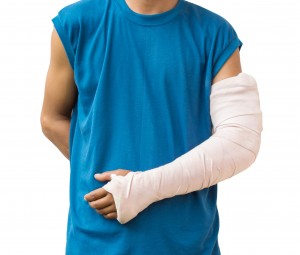Breaking a bone is painful, regardless of the location and type of fracture you’ve suffered. Breaks can sometimes result in skin injuries, whether it’s from an impact or from surgery afterwards. It’s quite common to have a scar form from skin injuries related to broken bones. It’s also possible to minimize the scar and make it less prominent. There are different types of breaks that result in scars, as well as different ways to manage scars with broken bones.

Incisions
Simply put, broken bones need medical attention. If they’re displaced, the bones may need to be set. This sometimes involves an open surgical procedure and usually an incision. For example, a rod or a pin may be surgically inserted into the body to provide stabilization and help the bone knit back together. Because several layers of skin are cut open, the surgical incision is sutured, then stitched or stapled together. Depending on the location of the break, your surgeon may be able to strategically place the incision so that it’s less noticeable when it heals.
After a few days to a few weeks, the sutures or staples are removed. New skin eventually forms in the incision area, creating a scar. After your cut has closed, the area can be treated to minimize scars. If the scar is very wide, you might be a candidate for scar revision surgery. After an operation, keep the area moist and clean as you would with any type of cut. You can also use scar revision cream on the pink skin. Follow your doctor’s recommendations on exercising and massaging the skin to minimize your scars and maximize your range of motion.
Open Compound Fracture
When a broken bone pierces the skin, it can be even more excruciating than a closed fracture because the skin and your nerves are traumatized. This type of injury creates jagged-edged wounds, which don’t heal as clean and clear as an incision. Depending on how the fracture happened, you could have dirt or debris in the wound. This can complicate the healing process and even result in an infection. It’s important to work closely with your doctor to make sure that you have the best outcome. The wound may not be in a straight line, but careful wound closure by a professional can help to reduce the size and shape.
After the wound is closed and the scab has fallen away, you can see a physical therapist to begin scar massage therapy. This is especially helpful in areas near the joints, where the less elastic, newly formed skin can constrict your range of motion if it’s not managed properly. Silicone scar gel is effective in minimizing compound fracture scars and helping them fade, even if they’re raised or bright in the beginning. Other ways to manage open compound fracture scars include monitoring them for infection, keeping your body hydrated and elevating the affected part of your body above the heart when possible.
Skin Injuries
Sometimes a bone can fracture without breaking the skin’s surface, but a blow to the outside of the body can still result in a cut or a gash. These wounds can be treated and cleaned by medical personnel at the same time as the fracture. You might need stitches or skin glue, depending on how deep it is. On the other hand, you might just need a bandage to help it heal faster.
During rehabilitation of your broken bone, be sure to follow your physician’s and therapist’s instructions for best healing results on the fracture and the related wound. Don’t pick at the scab that forms, even if it’s itchy. Let it fall away on its own so that new skin can grow underneath. It’s helpful to keep your scar out of the sunlight to prevent it from becoming hyperpigmented. Once your wound is closed and new skin is forming a scar, you can use scar treatment gel to minimize the intensity. One option is to use sunscreen on top of silicone gel sheeting to prevent UV exposure from sunlight.
For more information about scar treatment and tips, join our newsletter mailing list.

